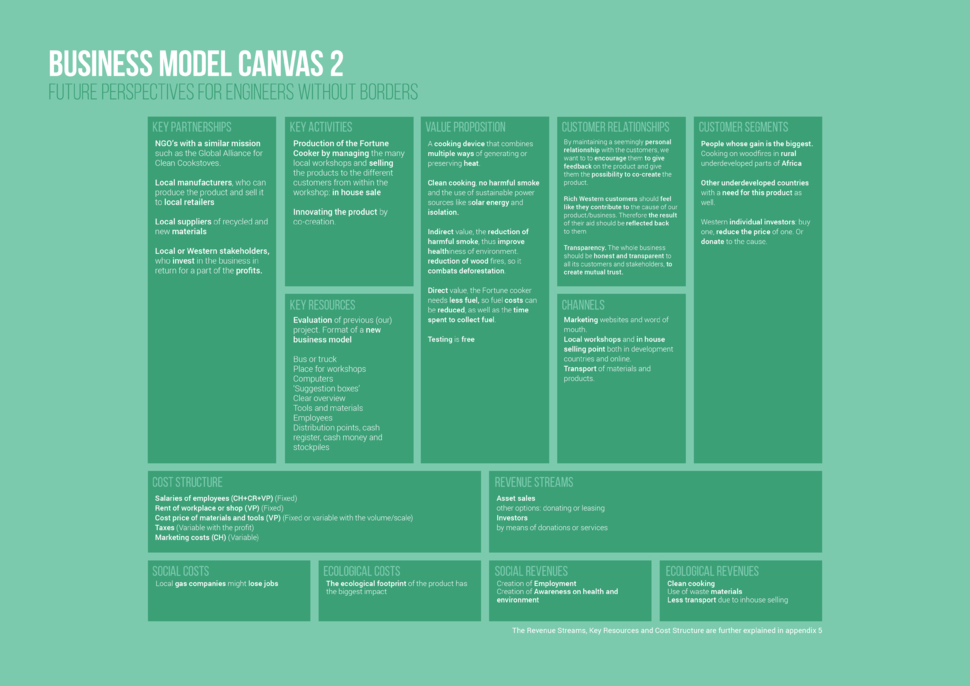Vision for the future
From the start, our primary objective has been that eventually, the Fortune Cooker can make a contribution that is lasting to the country that it is brought to: something that can sustain itself without Western intervention. There are several articles that attribute similar objectives to social and sustainable entrepreneurship. By studying these forms of entrepreneurship, combined with theories on successful development efforts, we can set up a viable business plan that will help the Fortune Cooker reach its target.
In ‘Business, but not as usual’, Vastbinder (2012) states that over the years, we have seen two types of relationships between high- and low-income countries: colonialism, and development aid, who are each on another extreme of the spectrum. Whereas the first exploited resources from low-income countries with a high profit and without social value, the second merely focused on the creation of social value without taking profits or losses into regard. Vastbinder also states that, even though well-meant, development aid has had the consequence that aid-receiving countries in time lacked independence and self-esteem. This is where sustainable entrepreneurship can prove to be effective: by setting up a business that can be run and preserved by locals, feelings of self-esteem and independence are recreated and local economy will eventually benefit.
By giving responsibility to locals, systems and designs can also be based on local needs, instead of on Western assumptions of what the locals need. According to Seelos (2004), this is essential for a social entrepreneurship to succeed; customers within the business model should be in a position to set requirements for the product offered to them’. It is not unthinkable that the Fortune Cooker will be slightly different in each country it will be implemented, seeing that we aim to make the product fit to the customer’s needs, by working together with locals and by working with local and recycled materials.
According to Prahalad (2002), there are four aspects to the successful implementation of a product in a low-income country. They are as follows: creating buying power; shaping aspirations; improving access; tailoring local solutions. In our business plan, we aim to create buying power by creating new job opportunities, as well as improving the local economy. By setting up workshops for the manufacturing of the Fortune Cooker, we generate jobs; by making manufacturers and retailers franchisers, the value chain stays within the country, and the local economy is improved. We aim to shape aspirations by making customers aware of the harm cooking on open fire can do, and how they can avoid this harm. By keeping the production line local, people can always have access to the product. We tailor local solutions by adjusting the Fortune Cooker to the needs and wishes of the local customers and by using local materials.
The embodiment of this can be found in our business model canvas, which is on the next page. The canvas is still adjustable, and can be altered based on what we find out on location.
With this adjustments, we can make use of the six questions of Morris et al. (2003), which they use to analyse a business model:
How will the firm create value?
For whom will the firm create value?
What’s the internal source of advantage?
How will the firm position itself in the market place?
How will the firm make money?
What are the entrepreneur’s time, scope, and size ambitions
The firm is in this case the future entrepreneur that will carry out the project.
Sources
Morris, M., Schindehutte, M., Allen, J. (2005). The entrepreneur’s business model: toward a unified perspective. Journal of Business Research 58, 726-735
Prahalad C.K. (2002), The fortune at the bottom of the pyramid. Strategy and Business
Seelos, C. (2004). Social Entrepreneurship: Creating new business models to serve the poor. Kelley School of Business, Indiana University.
Vastbinder, B., et al. (2012). Business, but not as usual. Greenleaf Publishing.
